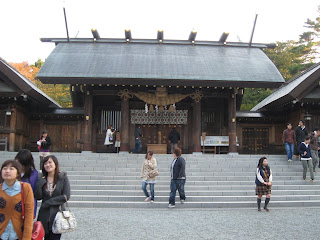Our time here in Sapporo is almost finished, and I thought it would be a good idea to talk about my host family. I was placed with the Sato family who - like the other host families for this student exchange - live in the Ainosato area of Sapporo, and within walking distance of the University campus.
 |
| Yuki, the game 'monster', at work in the arcade!!! ^^ |
There are four children in the Sato family, ranging in age between 5 and 12 years in age. I think that the noise level and energy level in this homestay is about the same as a Canadian household. Mrs. Sato is a full-time mother, activity manager and negotiator, while Mr. Sato works full-time as an counsellor and manager at a center for autistic adults in Sapporo. It has been a really great experience living with the Sato family, and sharing their home for the past month. The homestays were all arranged by the Hokkaido University of Education, and I think that they did an excellent job matching my personality to this family. Both my 'Mama-san' and 'Papa-san' are extremely kind and funny, and have done an amazing job making me feel welcome and accepted into their home.
Two Sundays ago, one of Mama-san's friends was visiting for coffee, and was curious about how Mrs. Sato had arranged to have foreign students from the University stay with her. Although the entire conversation was in Japanese, I could understand some of the basic steps Mrs. Sato had taken in order to arrange my homestay. Previously, the Sato family also hosted a russian student named Angela and an American named John. Mrs. Sato insisted that the process was quick and painless, and the benefit of having a homestay student was well worth the effort. Perhaps more for my ears than for her friend's, but nice to hear nonetheless. ^^
 |
| Me, John and Angela having a BBQ with Mr. Sato and family. |
For me, the most memorable thing about this homestay will probably be learning how similar a Japanese household is to most Canadian families. The routines of meals, school and homework can probably be found around the world, and seeing it here in Sapporo reminded me of my own childhood, and the basic roles and responsibilities typically found in homes of different cultures or languages. As a significant bonus, I was also able to practice my Japanese on a daily basis, and learned a great deal of valuable vocabulary and verbs from the children. Seeing them interact and play and argue also reminded me of my own childhood, while at the same time teaching me a new word or two that I can use for any future visits to Japan! :-)
 |
| Mrs. Sato slicing some delicious whale sashimi!! |
Most evenings, I have spent time with one or both parents, discussing topics ranging from education to cooking to language and culture. I think that in a very important way, the game I played with junior high school students here in Sapporo - "Same and Different" - is really just the same thing I have been conversing about nearly everyday with my host family. Regardless of the topic, it takes very little for either me or my host parents to get very excited and animated about noticing the differences and curiousities between our two countries. Even though our ability to communicate quickly is often hampered, gesture and a glass of good japanese beer has helped me be as patient and cautious as ever, and the trip of learning each new detail has always been worth it.
An opportunity like this one is really valuable to me, and I'm sure that Allyson, Sylvia and Jon would agree that it has contributed a great deal to our understanding of terms like 'inquiry' and 'engagement'. Yesterday, the university asked us to make exit presentations about our experiences visiting the various schools here in Sapporo, and all four of us could proudly include much of the pedagogy we had learned from the University of Calgary's Education program. I think that much of the work at HUE here in Hokkaido is closed connected with the philosophies taught in the UofC's lecture series, and is reflected in the research of our faculty in Calgary. In whatever way, I hope that this blog and our stories can help support a continuation of this exchange. At our going away party, several staff and students asked if it would be possible for us to return on this exchange again next year; I hope the answer can always be yes for someone from the UofC, to come and see another environment in which great teaching and research is practiced.

























 It is just a multi-cultural love-fest up in here, and I dig it.
It is just a multi-cultural love-fest up in here, and I dig it. 






















